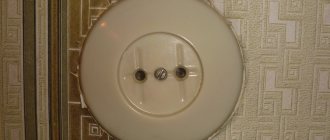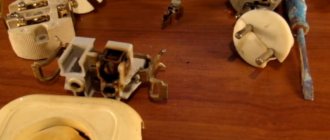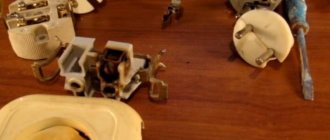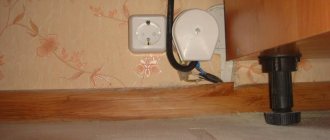Why does the socket spark?
Most often, sparking in a socket is discharges that occur when electric current flows not directly from conductor to conductor, but through a gas, an air gap between the conductors.
The socket sparks due to poor mechanical contact between the conductive parts of the electrical network.
Typically, sockets spark in two cases:
1. If there is a poor connection between the conductors of the input electrical cable and the terminals of the socket mechanism
2. If the contacts of the socket connector are poorly connected to the pins of the electrical plug
As you understand, sparking can occur not only in an electrical outlet; any unreliable connection of conductors can begin to spark. By the way, this is one of the main reasons for the small number of permitted methods for connecting wires in junction boxes during electrical installation.
Why is a sparking socket dangerous?
So that you fully understand the possible consequences of a sparking socket, it is worth saying that the resulting discharge is similar in nature to lightning or an electric arc when operating a welding machine .
Of course, a breakdown in an outlet is usually not so destructive, but still. The sparking of the outlet ultimately causes the surrounding elements to ignite and, as a result, a fire . Electric discharges themselves, the temperature of which can reach several thousand degrees Celsius, and simply heating of the socket conductors, which causes sparking, are to blame for this.
Also, in certain cases, sensitive electrical equipment and devices plugged into such an outlet may burn out.
In any case, if you notice that your outlet is sparking, you must immediately stop using it, and do not start without identifying and eliminating the cause of the problem.
Loose contact connections
The same effect occurs if it is not the connector contact that loosens, but the wire connection. They may not be tightened enough initially, so they will loosen over time, and an area with transient resistance will appear on them. The further process is similar to that described above, with the only difference being that it takes a longer time. It is believed that contacts need to be tightened periodically. But practice shows that with initially high-quality tightening of copper conductors, they will never need to be pulled. But aluminum wires need to be tightened, since they are softer and tend to gradually deform under the action of the mounting screws. Another property of aluminum affects the heating of contacts: when bent, the wire breaks. An inexperienced electrician may not notice this; the wire looks intact, but in some place it is enough to bend it a little for it to break completely. Heating also begins at this point and is transferred to nearby metal parts. As a result, the wire sparks and burns out. That is why the installation of new electrical wiring in residential premises using cables with aluminum conductors is now prohibited.
What to do to avoid breakdown
You can prevent a malfunction by fulfilling the following conditions:
- When using a switching connection in the form of a plug connector, use the same type of connection elements; use the socket only for its intended purpose and in accordance with the operating rules.
- If the product is made of poor quality materials, it must be replaced.
- Use tested devices that have certificates of conformity. Purchase in specialized stores, not in markets.
- If the electrical strength of the insulation of wires and cables is low, replace them with new ones that meet the requirements for electrical wiring. The need for replacement is determined during preventive tests or when emergency situations occur in electrical networks.
- If the screw connection of the wires with the contacts is loosened, they must be tightened. When using clamps (spring mechanism) in a specific model, the correct solution is to replace the product with a new one equipped with screw clamps.
- Use devices and devices that correspond to the rated current of the installed plug connection. The rated current value is displayed on the socket body, and on devices - in the passport and on structural elements (housing, inventory plate, tag, etc.).
- If carbon deposits appear on the contacts, you need to thoroughly wipe the connection points with a rag moistened with solvent.
- If the connected device has a toggle switch or an “On/Off” button, always use them, and not just pull the plug of the working device from the socket.
- In wet rooms, use only sockets with an appropriate level of protection.
- Install a circuit breaker on the line of outlet groups that matches the wiring capabilities.
This is interesting: How to find a short circuit in the wiring of a house or apartment: we reveal the essence
Precautionary rules and tool kit
The electricity needs to be turned off. You need to unscrew the plugs or block the machines on the dashboard. Work is carried out using special gloves. They are called dielectric. Gloves are made of latex or rubber and prevent current from entering the skin.
Residents must be warned about the work being carried out. Otherwise, someone might turn on the electricity.
Tools to repair the socket will require:
- straight screwdriver
- crosshead screwdriver
- pliers
- wire cutters
- multimeter
- insulating tape
- cable cutter
It is important that the handles of the tools are securely insulated. Sometimes a file and sandpaper are also required
It’s worth stocking up on them just in case.
How to fix the problem
If the sockets spark, you need to call an electrician or try to fix the problem yourself. First of all, turn off the power to the panel and warn the apartment residents about the repair. To inspect the contact part, you will need to remove the front panel.
Worn wiring can cause sparks to form in the outlet.
Procedure:
- Check the condition of the wires; oxidation on the copper must be cleaned with sandpaper.
- Tighten the screw terminals with a screwdriver and bend the contact plates.
- Inspect the wiring; if there are exposed areas, cover them with insulating tape.
- Secure the structure with the set screws located on the sides.
You can check the quality of the repaired structure by inserting a plug. A tight crimp of the pins indicates that the main problems have been eliminated. After the electricity supply is restored, the point is checked by turning on a medium-power appliance, such as an iron. If the result is satisfactory, it is recommended to periodically monitor the condition of the plug connector.
If the contacts and plastic are blackened and charred, it is better to replace the socket. If the standards do not meet, you will have to buy a modern electrical installation product of a suitable type. It will ensure normal use of household appliance plugs.
If the socket cracks during operation
If a cracking sound is heard when the plug is in the socket, then this is already a sign of poor contact in some part of the electrical circuit. Often, over time, the surface of the plug or the socket itself heats up, or even all at once.
Causes of crackling noise in a working outlet
In fact, a working socket makes noise for the same reason as when inserting a plug - the contacts do not touch closely, and in some places they do not reach each other. The consequences are standard: their surface oxidizes, resistance to electric current increases and the metals begin to heat up.
In the same way, a socket cracks if the bolted connections are loosened - the wire inside the contact begins to move and protrusions form, between which sparks appear. The socket begins to make noise, and if the contact is very bad, it can heat up and melt.
Also, the cause of sparking may be a mismatch in the diameter of the pins of the plug and the contacts of the socket; a typical example is when an old Soviet plug is inserted into a modern Euro socket.
Euro plug on the left, Soviet plug with smaller diameter pins on the right
Watch the details in this video:
The fourth common reason why an outlet gets hot is a mismatch between the power of the devices connected to it and the throughput of the wires. If you rub something against each other, both of these things will heat up, and the electrons inside the conductor “run” at the speed of light. As a result, if the wiring periodically operates at the limit of its capacity, then it warms up.
This is not critical for the cores themselves, but the insulation, which constantly softens and hardens, loses its properties over time. It is also necessary to take into account the ability of electric current to straighten the wiring through which it is passed. When a powerful device is turned on through a weak conductor, the heating core heats up the insulation, which becomes soft and is “picked apart” by the wire trying to straighten out. Ordinary vibration, which appears in devices powered by electric current, can also have its say. It may not be noticeable to the naked eye, but such wiring does not always short out immediately. Over time, the core may come out of the insulation and then, at best, there will be a sparking contact, and at worst, it will lead to a short circuit.
Elimination methods
Usually, when sparking occurs, it is enough to sort through the sockets - if you take them apart, then what to do next is usually visible to the naked eye. The place with poor contact is marked with scale from the melting of the insulation, and the insulation itself is hardened and brittle. If there is little carbon deposits, you can simply clean it off and tighten the bolted joints. When it comes to serious melting of the insulation of the wires or the socket body, it is strongly recommended to replace them.
Selection of sockets, plugs and tees
The reason for the incorrect operation of the socket may also be the poor quality of both the socket itself and the plug of the electrical appliance; this problem is discussed in detail in the following video:
Preparing to repair the outlet yourself
After carrying out a visual inspection and finding out the exact causes of the malfunction, you can begin preparing for repairs. First of all, let’s get ready for work, stop panicking, worrying and being nervous. Determination and calm are the main weapons needed for successful repairs.
Next, be sure to turn off the circuit breakers and switches on the meter, transferring them from the ON state to the OFF mode. We unscrew the plugs and automatic fuses.
This must be done carefully so as not to accidentally touch the live fragments with your hand. This way you can completely de-energize the room. It is also important to check for voltage in the outlet that needs repair. This is done using an indicator screwdriver.
Socket repair tool kit
In order to leave only good impressions after the repair, you need to have a set of available tools for all occasions.
Repairing, replacing and altering sockets is much easier to carry out if you have tools such as:
- indicator screwdriver for determining the phase and the presence of voltage in the electrical network;
- Phillips and flathead screwdrivers;
- pliers or pliers;
- vinyl tape for insulation;
- sharp knife;
- soldering iron (in some cases).
One of the important points is that the handles of pliers, screwdrivers and other tools used must have an insulating coating or be rubberized. This will prevent accidental electric shock.
Do-it-yourself socket repair
After checking the voltage, it's time to start repairs. Using a screwdriver, unscrew the bolt located in the center of the connector. This allows you to remove the socket cover and gain access to the filling. Checking the status of the contacts. If the copper has a greenish tint, this is a sign of oxidation; if it is gray or black, this is an indicator of poor contact.
The veins can be distinguished by color. The most popular method is: zero - blue cable, phase - red/white, ground cable - green-yellow
How to properly repair such an outlet? For example, when the contacts are dark in color, they need cleaning. A needle file is usually used for this, but you can use sandpaper. There are situations when the metal in certain places has become much thinner, and through holes appear on the contacts themselves. In this case, the socket must be replaced.
We tighten loose contacts
After removing the socket from the wall, it is necessary to tighten all fasteners, screws and contacts with an appropriate screwdriver. If the wire or terminals have an uncharacteristic color or carbon deposits, you can use a sharp knife and clean them to make them shiny.
Heavily charred wires must be replaced with a new piece or simply cut off (with sufficient length). Any wire connections and twists must be insulated with vinyl tape. A socket whose contacts are damaged cannot be repaired and requires complete replacement.
Typically, the plug enters the power socket under a certain pressure. This is ensured by contacts that are well matched to one another. If not, then we are working on solving this problem.
After this, you need to check how securely the wires are connected directly to the outlet. If necessary, tighten them, but not too much. They should not twitch or fall out. Each exposed wire that is connected to an outlet must be well wrapped with electrical tape.
The spacer “tendrils” of the socket, stuck into the installed plastic socket box, will be able to firmly hold the socket from popping out for a long time
What to do when the entire socket moves from side to side? The solution to this problem is quite simple. It is necessary to tighten the installation bolts located on the left and right. If they are tightened well and correctly, the socket will sit in its place.
Connecting a new outlet
First of all, the power wire is connected to the contacts. To do this efficiently, you need to remove 5–10 mm of insulation from the core through which the current will flow. The exposed part of the wiring must be inserted into the terminal and pressed tightly with a screw.
There is no need to be too zealous when tightening the screw, otherwise this will lead to the wire being squeezed, and in the worst case, breaking.
There are two ways to connect the wires: quickly or securely. A reliable connection means that the ends of the stripped wires will be bent into a ring of small diameter (4–5 mm). Only after this should they be inserted into the terminals and tightened. Quick connect allows for simple connection without twisting.
A reliable method of connecting contacts requires much more time, but is compensated by a number of advantages, for example:
- contact is stronger;
- the degree of heating of the contact is much less, since the area of contact of the wire with the current-conducting contact is much higher.
Connecting an outlet with grounding differs slightly from installation without it. A wire, usually green, is connected to the ground terminal. Before connecting, you should make sure that this core is indeed a ground wire.
A wire with several cores can also be tinned before connection. You can use a soldering iron for this.
The next step is to install the device in a socket box. The working part is installed after all wires are fully connected. Installation takes place at the same level as the wall, without distortions or protrusions. All wires must be neatly twisted and hidden in the socket box.
The socket is secured in the correct position using special clamps. They can be adjusted thanks to screws. If you twist them, the claws will fix the socket from the inside.
If your socket does not have claws, then this is a new type of device, which is fixed in the socket box using the clamping screws provided for this purpose. The last step is screwing on the lid.
The cover can be screwed on after successful completion of the socket installation; the working part must be tightly screwed into the socket box
How to eliminate sparking in an outlet?
Having dealt with the reasons, let's move on to ways to eliminate each of them. Let's start in the same order:
- Mismatch between plugs and sockets can be easily resolved. It is necessary to bring them to a single type. We recommend choosing modern standards, otherwise you will need to change the plugs on each newly purchased electrical appliance. That is, we are replacing Soviet sockets with European standards. In addition, if the house has vintage electrical equipment, we replace the old plugs on it.
- To eliminate an outlet overload, you can go in several ways:
- Replace the electrical installation device with a more powerful one. For example, if the outlets are rated at 10.0 A, then replace them with 16.0 A products.
- If one outlet is not enough, then install an outlet block. This will be much more reliable than using a tee. If for some reason there are difficulties with installing the socket block, use a double socket installed on one seat. Double socket
- You can try to repair a worn plug connector if the case is not very advanced. To do this, you need to remove the socket (after de-energizing the line from which it is powered), clean it, and then bend the contact plates using duckbills (thin pliers). If the socket cannot be repaired, we replace it.
Remember that frequent plugging will shorten the life of the plug connector.
- If the clamps are loose, tighten the contacts (after turning off the power). For copper wiring, it is recommended to repeat this procedure every 5-10 years; for aluminum wires, not once every two years. If possible, replace the wiring with copper.
- Do not purchase low quality products. Savings in this case are somewhat inappropriate. It is not too difficult to distinguish a counterfeit from an original; first of all, it is a suspiciously low price and the lack of certificates for products. This product is also characterized by low quality plastic housing, lack of packaging, and incomplete packaging.
Connecting enabled devices
This point will be valid regardless of the manufacturer. If the permissible power is exceeded by the sum of the powers of all connected devices and consumers, both the plug and the good quality socket will begin to heat up. The chance of a spark greatly increases, and the situation can develop into a fire hazard.
Connecting enabled devices.
If you connect above the rated power to sockets of poor quality, they will fail very quickly. In general, electrical installation products are not designed for loads higher than the values set by the manufacturer. It is also dangerous for wiring inside walls and inside the house.
Socket sparks: possible reasons
Next, remove the wires from the outlet. Now, you can prepare a new socket, or use the old one. The wires are cleaned to a shine, as are the contacts in the socket. Now the stripped wires are attached to the socket; tighten the bolts holding the wires well. Also check that the plug is not loose in the socket, since due to poor contact between the plug and the socket, the socket may become heated again and one of the contacts may begin to melt.
Perhaps this is due to contacts that have “moved away”, so to speak. Therefore, proceed in the following way: de-energize the outlet (turn off the circuit breaker through which power is supplied to it), unscrew the cover of the outlet and, if necessary, pull out the “body” of the outlet itself from the wall, tighten the bolts that hold the wire. This way you tighten up your contacts. Look carefully to see if there is a break in the wire. And one more thing: keep in mind that if there is even the slightest trace of burning on the outlet itself, it is better to replace it with a new one.
troubleshooting
Once the preliminary work is completed, you can start looking for breakdowns. As a rule, the wiring in the apartment has a standard wiring. The exception is cases when the previous owner has already remodeled it in his own style.
All sockets do not work
If you find that a particular outlet is not working, use an indicator screwdriver to determine the phase. If available, it is better to use a two-pole device.
The reason is that if the zero is broken, the indicator screwdriver will still show the phase. In this case, the outlet will not work.
Now check if the other outlets in the room and house are working. If there is no voltage anywhere, pay attention to the position of the input circuit breaker. There is a high probability that it was simply knocked out due to a short circuit.
Other options are also possible - breakage of the junction box or damage to the wiring to the first junction box.
There are situations when the lack of voltage is caused by a malfunction of the machine. For example, it is turned on, but no current passes through the contacts.
In this case, measure the voltage at the input and output. If there is no output at the output when the circuit breaker is on, it is necessary to replace the device or have it repaired.
Doesn't work in a private room
If there is no power to outlets that are only in one room, a group of devices may be disconnected.
In some apartments, a separate circuit breaker (AB) is installed for each room. If so, try disabling and enabling it.
The reasons for failure of a group of sockets may be the following:
- increased load on the machine;
- tripping the circuit breaker due to a short circuit or overload in the controlled area.
To troubleshoot, check the integrity of the wires in the panel and sockets. The rest of the wiring cannot be inspected, because it is hidden in the wall.
Alternatively, you can look into the junction box, which is located in the “problem” room. Perhaps this is where the short circuit occurred.
If the voltage to the machine is suitable, but the sockets in the room do not work, it is better to call specialists. The technician must find and replace the damaged area.
In most cases, the cause of the malfunction is hidden in careless installation of electrical devices or insulation failure. An additional nuisance that can occur in an apartment is moisture getting into the outlet, which can cause a short circuit.
One socket doesn't work
If the problem occurs with only one outlet, the cause may be a poor connection.
It should also be taken into account that when several devices are connected in parallel, the loss of a common zero or phase can lead to a malfunction of the entire group.
In this case, you need to turn off the power to the apartment, open the socket housing and inspect the quality of the connections. If the contacts are loose, they need to be tightened.
It happens that due to a heavy load, the wire burns out or simply breaks off due to improper installation. In this case, it must be cleaned and inserted into a special connector.
Please note that the contacts in the socket must be well tightened. Otherwise, under heavy load, the wire will overheat and it may even catch fire.
Problems in the junction box
Sometimes the reason that the outlet in the apartment does not work is the junction box. This device may also have a short circuit, broken wire or poor contact.
Here the algorithm of actions is as follows:
- turn off the power in the apartment (turn off the common circuit breaker);
- open the box;
- check the voltage level at the input and make sure that it is missing;
- check the condition of the contact group (disconnecting the wires may be required);
- If the wire is broken, strip it and make a new twist.
When inspecting the box, pay attention to the condition of the wires. Perhaps one of the contacts there has burned out. Evidence of damage may include oxidation, darkening, and other problems.
In this case, bite off the old area and clean the new one. If the wire is not long enough, simply clean the problem area with sandpaper. Next, twist the wires and wrap the area with several layers of electrical tape.
The overhead light works, but there is no socket
Another common situation is when not a single outlet in the apartment works, but there is lighting. In housing with two or more rooms, only half of the electrical outlets may fail, and light bulbs will be on everywhere.
In many apartments, the light and power parts operate from different circuit breakers. Perhaps the circuit breaker that powers the outlets has turned off due to an overload or a short circuit.
Try turning on the AB and pay attention to its further behavior.
If, after turning on the machine, the sockets in the apartment still do not work, the reasons may be as follows:
- Breakdown of the circuit breaker (needs repair or replacement).
- The wire on the AB or zero bus has burned out (recovery is required).
- Junction box. If there is voltage on the meter, the AC is working and there are no burnt wires, the reason may be in the junction box (we have already discussed this above).
The simplest case is when the problem is caused by the machine being turned off (just turn on the AV). In other situations, repairs and calling a technician may be required.
Sockets do not work, but there is a phase
A non-standard situation when a check shows the presence of a phase in the socket, but the household appliances in the apartment still do not work. The reason may be a missing zero.
This is possible in the following cases:
- the contact of the old wiring has burned out;
- knocked out the zero plug (relevant for old houses);
- open circuit;
- burning or oxidation of contacts at clamping points;
- metal corrosion on copper or aluminum (depending on the wire material).
There are situations when unscrupulous electricians connect copper to aluminum, which, under heavy loads, leads to plaque and loss of contact or burnout.
Crackling noise when plugged in
This phenomenon is observed quite often - for example, if you leave home for several days and unplug electrical appliances from the outlets. Upon returning, everything turns back on and then a noticeable flash is visible in some sockets and a loud crack is heard.
Causes
Despite the fact that this all looks quite threatening and causes many to reflexively pull their hands away from the sockets, there is nothing in this phenomenon that indicates a malfunction. It’s just that when the contacts of the plug approach the contacts of the socket, an electric arc jumps between them an instant before contact. This is the nature of electric current and the higher the voltage at the contacts, the greater the distance such an arc can stretch.
In industrial conditions, special arc-extinguishing chambers are made near the contacts of starting devices, and in particularly powerful devices, devices are even used to extinguish the arc with compressed air or another method.
What’s interesting is that reflexively withdrawing your hand from such an outlet is completely meaningless. And not because this phenomenon is not dangerous, but because of deception of vision and hearing due to the imperfection of these sense organs. The fact is that the microlightning that occurs when contacts touch lasts a hundredth, if not a thousandth, of a second. Given that the human eye perceives everything at a speed of 24 frames per second, it only sees the original image captured on the retina and gradually fades away. It’s the same with sound - an audible crack is thunder in miniature - first the primary disturbances of the air reach the ear, and then the consequences of displacements of its molecules.
What can be done
It would seem that the issue has been resolved and now you can simply not be afraid of this phenomenon, if not for one “but” - not every socket sparks... This is even more surprising if all the installed sockets are the same, which means that this behavior cannot be explained by differences in design.
The reason is simple - plugs from switched-off devices are inserted into some sockets, and plugs from switched-on devices are inserted into others, on the contrary. Take a computer for example - usually all its peripherals are connected to one surge protector with 5-6 outlets. This is the system unit itself, a monitor (or even two), speakers, a printer, a router - maybe something else is connected. When the computer is turned off, in fact, it is not completely de-energized - all its components are in standby mode, so if you unplug the surge protector from the socket, it will “remember” its last state. Accordingly, when the plug is inserted into the socket again, all devices will simultaneously “fucking” the electric current, which will cause a discharge in the socket.
This will not happen if, before leaving, you turn off the power to each device separately - manually turn off the monitors, turn the switch on the power supply of the system unit, flip the toggle switch on the speakers and the printer. Then, when the plug is plugged into the socket, the circuit will not close and there will be no discharge.
How does this affect the outlet?
Theoretically, when even microlightning occurs, the surface of the contacts burns and may become unusable over time - the resulting soot will cover everything with a film with high resistance, this place will begin to heat up and the socket may begin to melt.
In practice, the discharge hits the tip of the plug and the very beginning of the socket contact - when the plug is fully inserted, the working surface of the contacts is completely different. Moreover, if the plug is not taken out of the socket often, then the contact is very far from being damaged.
As a result, when the socket sparks when you turn on the plug, you need to realize that everything has already happened and simply insert the plug further.
Why does the socket spark?
First of all, you need to be well aware of the conditions under which a spark can form. From a physical point of view, each such spark is a kind of electric arc in the form of an ionized gas section through which electric current flows. Unlike metal conductors, where the current moves imperceptibly to the eye, a luminous flux is formed in a gaseous environment during the movement of charged particles.
Exactly the same situation occurs at the moment of contact between a plug and a socket that have a potential difference. At this point, enough electrons are produced to create a current that causes breakdown. The intensity of sparking depends on the network voltage and the power of the connected devices. The higher these parameters, the more noticeable the sparks will be at the electrical contact points.
The appearance of sparks in an outlet can occur for several reasons. One of them is the presence of a certain resistance value on the power cord or in the electronic circuit included with the design of the device. If there is a capacitor at the input of the circuit, the sparking effect increases even more. In this case, there may be no power button at all, or it may be turned on even before the device is connected to the outlet. Therefore, even the highest quality socket will spark at the moment of contact with the plug. To avoid this, it is recommended to use a switch installed on the device itself.
Another common cause of sparking is the incompatibility of old plugs installed on household appliances and new sockets manufactured according to European standards. The contact parts of old plugs have a smaller diameter compared to the female contacts of new sockets. This mismatch leads to loose fitting of the plugs in the sockets, and contact between them is only partially achieved. In fact, there is a constant interruption of electrical contact between the conductors. As a result, such intermittent contact causes constant sparking and subsequent complete failure of even the highest quality socket. Therefore, during operation it is recommended to use products of a single standard.
Often old sockets completely exhaust their service life and are in a worn-out condition. The crimp contacts are coated with a layer of carbon deposits, which creates additional resistance. Therefore, when turned on, the plug first touches the carbon deposit, which leads not only to poor contact, but also to sparking. The contact jaws themselves may become loose, causing a decrease in their crimping ability and the occurrence of sparks. The best solution to the problem would be to replace the socket, but if this is not possible, you should carefully tighten and clean the contacts of the old product.
Sparking sockets also occur as a result of an overloaded electrical network. As already noted, as the power of consumers increases, the spark at the contact points also increases. For example, if several powerful devices are connected to an extension cord simultaneously, then all this power is summed up, and the entire load falls on the outlet into which this extension cord is plugged in. At the moment such a total load is connected, a very strong spark appears in the outlet. With regular use in overload mode, any socket will fail, despite its high quality and technical characteristics. Therefore, it is better not to remove the plug from the socket unless necessary, and to turn on the devices either with their own buttons or with a general switch located on the body of the extension cord.
Causes of sparks in an outlet
The purpose of a plug socket is to connect the plug to the electrical network. During normal operation, current flows through the contacts with minimal heat generation. In some cases, when inserting a plug into a socket, a breakdown occurs. The higher the power of the device being turned on, the more intense the sparking and crackling. The temperature of the electric arc is very high, and a characteristic smell of molten plastic appears.
Sockets crack for several reasons:
- Exceeding the power for which the electrical installation product is designed.
- Long service life and natural wear of connectors.
- Loosening of contact clamps.
- The plug connection parts are manufactured to different standards.
- The product supplied was of low quality and had a short service life.
If the socket shorts out when you turn on electrical appliances, you should temporarily use another power point. There are several factors leading to failure.
Overload
Electrical installation structures are designed for a certain rated current. The parameter is indicated by the manufacturer on the panel. Before the advent of powerful household appliances, it was sufficient to install a product with a current of 6-10 A, now the figure is 16 A. For three-phase networks, the parameter is at least 32 A. Exceeding the rated current leads to heating of metal parts. High power of equipment increases the load on electrical wiring. For safety reasons, it is made of cable with copper conductors.
The formula P=IxU will help you calculate the permissible power, where P is power, I is current, U is voltage. For example: P=10×220=2200 (W). A socket with a rated current of 10 A can withstand connecting devices with a total power of up to 2.2 kW.
Overloading leads to burnt contacts. The remaining plaque reduces conductivity and increases resistance. In proportion to these factors, heat generation increases. The socket may burn out, and along with it the equipment.
Worn connectors
The contact terminals bear a high load. They are designed for a specific resource. After several years of use, if you frequently insert and pull out the plug, the contact plates will loosen. They do not fit tightly around the pins. Intermittent contact causes crackling noises and sparks. The socket begins to warm up and hiss when the metal is covered with a layer of oxide. The process arises from moisture. The springing properties of oxidized metal are reduced. To extend the life of the device, it is worth turning off the devices with a special button, and not by pulling out the plug.
Loosening screw terminals
If you hear a cracking sound in the socket, the cause may be loose screw connections. The situation arises due to heating and deformation of the metal. The process occurs in all electrical installation products, so experts recommend carrying out preventive tightening of contacts once every 2 years. Aluminum wires are checked more often. When pulling, it is important not to pinch the core, otherwise it will become deformed. One of the mistakes that unskilled installers make is using a long screw. The fastener rests against the wall and does not allow the contact to be properly tightened.
During installation, it is advisable to wrap the wire in a loop around the screw. This method significantly increases the contact area. Modern devices are manufactured using screwless technology. Their installation is simplified and preventive maintenance is not required.
Mismatch of selected plug parts
plug Plugs and sockets are manufactured to standard sizes. In Russia, two designs are used:
- The European Type C or Europlug is a plug with two parallel round pins. The distance between them is 19 mm, diameter 4 mm.
- Type F or Schuco - plug with protective contact, grounding. It is widely used in Europe, popular in Russia and the CIS countries. The plug pins have a diameter of 4.8 mm.
The European plug is quite suitable in size for old sockets, and the F type is slightly larger than the design parameters. Repeated connection of a large plug leads to expansion of the contact plates. When inserting the Euro plug, the crimp will be weak.
Also, due to poor contact with plug C, the socket intended for type F plugs sparks. The connection is acceptable for low-power devices, but overheating occurs with high power consumption.
Poor device quality
Inexpensive electrical installation products quickly become unusable. They use thin plates, unreliable fastening, and the contacts are loosely tightened. Chinese products have low cost due to low quality. It does not correspond to the declared power and quickly becomes loose during operation. Due to the high load, the sockets hiss and fail after a maximum of 2 years.
a) Original Legrand socket, b) Counterfeit
High-quality products in the budget segment - products from Vico and Makel. European brands Legrand and ABB have inexpensive series.
Why are the sockets humming, what should I do?
If the socket makes sounds (noise) or buzzes... This means there is poor contact between the wire supplying the socket and the plug that is plugged into the socket. Note that noise appears when a load is connected. There is no noise without load. We turn off the power to the outlet. Turn off the circuit breaker. We disassemble the socket. We remove the cover and visually see if the contacts are burnt or not. Maybe the fork clamps became more loose than they should have been. The result is poor contact between the plug and the socket. The fork may also get hot. The next possibility is that the contacts between the wire and the terminal blocks of the socket are burnt. The wire may also be oxidized or burnt. Due to this, the diameter of the cores became smaller and the load in this place increased. We unscrew the terminal blocks, pull out the wire from them, strip it or trim it, bite off the old burnt one and strip the insulation from the new one. We clean the terminal blocks from burning or traces of oxidation or replace the socket with a new one.
Most likely there is one reason: the wire contacts were loose or loosened as a result of use. Because of this, the contacts become charred and begin to heat up and hum. Here's what needs to be done: You need to turn off the power in the house/apartment. Open the socket cover. Then unscrew the socket itself from the wall.
Socket sparks due to overload
A socket, like, in principle, any other household appliance, has certain characteristics and parameters. Each product is marked accordingly. For example, a 16 A and 250 Volt outlet can withstand a load of 3.5 kW.
- 6 Amps – 1.3 kW
- 10 Amps – 2.2 kW
- 32 Ampere – 7 kW
Exceeding the maximum permissible loads will lead to overheating of the socket contacts. As a result, they burn and resistance increases. Based on this, we can conclude that a large number of extension cords and overly powerful devices cannot be plugged into one outlet.
What to do if the socket sparks
The main cause of sparking in sockets is poor-quality broken contact between conductors. Due to the loose fit, electricity enters the air, resulting in a spark gap. A kind of small lightning appears in it, which is considered an electric spark.
Socket repair:
Before you begin repairing the outlet, you must turn off the power supply and make sure there is no voltage. To gain access to the functional module, you must first remove the decorative cover. First, the condition of the wires secured in the clamps is checked. They should not be broken, burnt, oxidized or covered with soot.
You should pay attention to the presence of scale on the contact plates and mounting bolts, since oxidation reduces the spring properties. High-quality products are additionally equipped with springs that press the contact petals. Carbon deposits are removed from the ends of wires and contacts without the use of sandpaper
When tightening the contact clamps, force must be applied. Burnt-out wiring is freed from insulation. After inspection and elimination of deficiencies, the decorative overlay is installed in place, and electricity is supplied to the network. A table lamp or some other low-power device equipped with a power button is connected to the outlet. During the check, you need to pay attention to the pins of the plug, which must fit very tightly into the sockets and contacts of the socket with force. This will prevent sparking due to the mismatch of these products with each other. If the sockets are connected to the installation box using a cable, it is recommended to provide for the laying of two phase and two neutral ends in advance. Many modern sockets are additionally equipped with a grounding contact. If there are no visible faults, you can connect something more powerful, for example, a vacuum cleaner or iron. If after switching on there is no sparking or heating, then the socket repair was carried out correctly. It is recommended to monitor the operation of the outlet for a certain time with the electrical appliance turned on.
If all of the above measures do not produce positive results, it is necessary to completely remove the working part of the socket from the installation box and conduct a more thorough visual inspection for damage to any other elements. Loose contact sockets are tightened with pliers, and clamping bolts with damaged threads are replaced with new ones. If restoration and repair are impossible, the working module must be replaced completely.
Timely prevention is of great importance. Many homes still use aluminum wires to carry electricity to electrical outlets. Since aluminum is a very soft metal, you should regularly tighten the connections between the wires and the contacts. It is recommended to select the sockets themselves in accordance with the maximum current, the value of which is marked on its body.
All household appliances are equipped with power buttons, regulators or toggle switches. With their help, the device itself must first be turned off, and only then the plug is removed from the socket. Before connecting, on the contrary, all devices must be turned off.
If an outlet in the house sparks when connecting or disconnecting household electrical appliances, it is necessary to take urgent measures to eliminate the malfunction. In practice, this problem becomes a frequent cause of fires. Let's figure out what causes the sparking of the electrical contact in the plug connector and, depending on the cause, we will choose the optimal repair method.
Why can a socket light up even if nothing is plugged into it?
A house fire is scary. Most often, the cause of fire is careless handling of fire, but electricity also accounts for a huge number of incidents.
Unfortunately, even following the rules for working with electrical appliances cannot protect your home from an electrical outlet catching fire. It can catch fire even if nothing is included in it. The article explains in detail why this happens and how to minimize the risks.
Main causes of fires
As simply as possible, a socket can be represented as two wires (contacts) placed in a plastic box and not interacting with each other in any way. When, for example, a plug is inserted into it, the metal connects both wires and current begins to flow into the electrical appliance. If the wires are not connected by anything, fire is impossible.
Indirect connection
The most common cause of fire is a transit or end-to-end connection. It is absolutely ideal when separate wiring is laid to each socket from the distribution box. Very often, in order to save money, only one is connected directly to the box, and this is very dangerous.
For example: there are 4 sockets in a room, one of which is transit, and the remaining three are powered from it. If you insert 6 electrical appliances into such a network, 2 in each socket except the main one, all 6 devices will be powered from it. An overload will occur, the contacts of the main socket will begin to heat up, the plastic will melt and, as a result, the wallpaper may catch fire, followed by the whole house.
A pass-through connection can be even more dangerous, as in some older homes the same outlet may be connected to two different apartments. Even if one of the neighbors does not use it, the other can connect an air conditioner, refrigerator and TV through an extension cord.
If a fire breaks out, it is highly likely that it will spread to both apartments. Fortunately, both backhaul and end-to-end connections are not used at the same time, so this development is unlikely.
Accident: insect or foreign object
Cases where an insect shorted contacts, died and caused a fire are quite rare, but there are stories from victims online.
Another reason is the ingress of any object that can close the contacts. There are known cases when a child played electrician during a preventative power outage, and this became known only after it was turned on.
How to avoid fire?
First, you need to consult a specialist. He must determine which sockets use a direct connection, and which use a through and transit connection. This is enough to avoid overloading the network with electrical appliances and eliminating the main cause of the fire.
Disadvantages of electrical wiring
The daisy chain connection of sockets brings many problems for consumers. This is when the cable from the panel or junction box goes to one outlet, from it to the next, and so on. The cable cores are connected under one screw. With this scheme, the total current of all electrical appliances connected to the loop flows through the first contact connection. But the connection itself is also designed for the rated current of the outlet. This is why even under a light load the plug in the socket sparks and melts: it is heated by the currents of electrical appliances connected to neighboring sockets. You can eliminate the loop by redoing the electrical wiring. All wire connections must be made in junction boxes, with a personal cable laid to each outlet. Perhaps these are all the reasons why sometimes the socket sparks when you insert a plug into it. Knowing the answer to this question will allow you to protect yourself from such an unpleasant and dangerous effect.
Overcurrent
Excessive current load can cause sparks to appear in the outlet. All sockets are designed for a certain threshold current in the network. Good quality products for larger ones, bad ones for smaller ones. Moreover, it is very important here how long the outlet will be able to withstand the maximum load close to the nominal value.
Overcurrent.
If you plan to connect many appliances or devices to one outlet, then buy one of good quality. There are many well-known companies that produce quality products. Such products are able to withstand loads near the maximum for a long time, without the consequences of failure in the future.
Inconsistency of plug and socket standards
In Russia two standards are used:
- type “C” or “Europlug”
: plug with two round pins with a diameter of 4 mm. Soviet-style plugs, still in use today, had the same pin diameter. - type "F" or "Schuko"
: plug with 4.8 mm diameter pins and ground pin. It is mistakenly called a "Europlug", although this term is a translation of the word "europlug".
If the socket is designed for type “C” plugs, then connecting type “D” to it leads to loosening of the contacts and increasing the gaps between them. Further use of plug “C” leads to insufficient crimping of its contact blades and sparking. Using "C" with "D" sockets, especially when drawing high current, produces the same results, since the contact system is not designed to crimp smaller diameter pins. Although manufacturers are trying to make the contacts universal, realizing that a socket with a grounding contact will not always be used only for connecting Schuko plugs.
Possible consequences
For those who are delaying the repair of a sparking socket, we recommend that you read this section carefully and then begin immediate repairs.
Without eliminating the cause of the sparking, the home master puts himself and everyone who lives with him at risk. A problem plug can cause a fire in your home. Sometimes a weak spark is enough for a fire to engulf a home.
The plastic of high-quality products is not subject to combustion, but this does not mean that it will not melt and if you try to pull out the plug, you may be exposed to the harmful effects of electric current.
You should not blindly rely on the operation of circuit breakers, especially if they were installed 5-10 years ago and were not checked after that. Connecting a high-power device or extension cord with equipment connected to it may cause the wiring to catch fire due to overload, and the AV may become faulty. In practice, such cases are not uncommon; it is especially surprising when a plug is inserted into a sparking connector, since it is located very conveniently.
To repair an outlet or replace it, it will take no more than 10-20 minutes, a maximum of twice as long if you lack the skills. But with a reliable electrical contact, the danger will no longer threaten your home.
The plug and body get hot
This symptom indicates that significant transient resistance has arisen at the connection point. This happens, as a rule, for the following reason. At one time, when the contact weakened, no repairs were made.
Over time, in the place of poor connection, under the regular influence of a small electric arc (accompanied by crackling), carbon deposits grow, which, being a poor conductor, heats up greatly when electric current passes through it.
Having opened the cover, you can make sure that the threads of the screws of the clamping terminals are burnt and the screws are “stuck”, and the copper contact plates have greatly changed color and, naturally, have lost their elasticity. In this case, it is impossible to repair them yourself.
If heating attracted attention earlier, the device can be repaired by cleaning the parts from slight carbon deposits and stretching the contacts
How to change the plug?
First you need to understand what kind of fork you need. This depends on a number of circumstances:
- device power;
- the need for grounding;
- current strength in the electrical network.
Usually the best option is to buy the same part as it was. Of course, unless the device was brought from somewhere very distant, where manufacturers do not consider it necessary to adhere to the usual rules.
Further:
- Prepare the cord - cut it at a distance of 3-5 cm from the plug.
- Remove the insulation to a length of 2 cm.
- Form rings at the ends of the conductors.
- Insert screws into the rings that already have groovers and flat washers on them.
- Screw the screws into both pins until they are tight.
- Place the pins in the housing, in special recesses.
- Place a strip over the wire.
- Press the bar to the body using two screws.
- Place a rubber tube (polyvinyl chloride will also do) where the wire exits the plug.
- Connect the body halves.
- Tighten them with a screw and nut.
Tags: machine, ampere, beat, boiler, sconce, view, plugs, harm, switch, house, , grounding, replacement, charging, sign, isolate, cable, like, kilowatt, computer, capacitor, , monitor, installation, power, load, voltage, nominal, crimp, overvoltage, potential, wire, start, , work, relay, repair, socket, row, light, twist, resistance, circuit, ten, current, transformer, , phase, filter, shield, power tool, Effect
Screw clamps are loose
Any dismountable product tends to wear out over time. All screws, latches, springs are unscrewed and weakened over the entire period of operation. The result of this, again, is poor contact of the electrodes with the network, as a result of which you can see how the socket sparks on its own (without plugging in the plug).
If the wiring consists of aluminum conductors, then the screw terminals need to be tightened several times a year, because aluminum tends to “leak”, as a result of which the contact weakens, from which it begins to spark. The connectors themselves where the plug is inserted may also be worn out. The plug is fixed using special clamping jaws, which unbend when frequently connected/disconnected. In this case, you need to bend them inward with pliers.
These two reasons are the most popular, and if sparking is detected in time, the situation can be saved by ordinary repairs. If you have already disassembled the outlet, carefully examine all other elements of the structure: perhaps intervention will be required somewhere else.
Video instructions for repairing an outlet that sparks
How to avoid problems: crackling in the socket
Above we described the main reasons why a socket may make noise and spark when the plug is turned on, and methods for repairing accessories with your own hands. Now we should talk about how to prevent problems, or in other words, about prevention.
Preventive measures are as follows:
- At least once a year it is necessary to inspect the wiring.
- You need to visually inspect all electrical appliances in the house.
- The plug must be inserted and removed from the socket smoothly; this can only be done when the power supply to the device is turned off.
To avoid serious problems and consequences, it is necessary to inspect the wiring at least once a year.
The course of action using TV as an example is as follows. Connect to the mains, press on. and vice versa - turn off the TV. We take out the plug from the electrical outlet. Install a circuit breaker on the outlet line, which will prevent overvoltage in the network and save not only the outlet.
Low product quality and wear and tear
The cost of installation products from different manufacturers varies over a wide range. Each product occupies its own price niche: not every buyer is ready to spend money on an expensive socket, switch, plug or lamp. It happens that even well-promoted brands do not meet the expectations of customers: each has its own advantages and disadvantages, and the contact system of sockets is no exception. Particularly influential is the fact that the contacts of the plug connector are structurally made in one piece with the contact for connecting the supply conductor. When you tighten it, you can deform the connector; the plug will come into contact with it not with the entire plane, but with part of it. At small loads this will not be noticeable, but at high currents heating of the contact is inevitable.
The socket connector must withstand repeated plug connections, as well as its long-term presence in it without changing its properties. In practice, the contacts of a low-quality plug are made of cheaper materials, the springing properties of which are lost much faster than those of more expensive products. This is why sockets spark when a plug is inserted - a loose contact system, when the pins move in it, periodically loses connection with them. During operation, heat will be released in the place where the contact is loosened, and a heating element that is harmful to it will appear in the outlet. When heated, surfaces become covered with an oxide film, which further increases the contact resistance and increases the temperature. The process inevitably ends with the heated part melting the plastic around itself, it flows inside the connector and sometimes even blocks the plug in it. The plug itself also heats up, sparks, and the hole around it melts. It is no longer possible to use such a product, and sometimes it is not possible.
Low quality
As I wrote earlier in my article “What You Shouldn’t Save on When Repairing,” electricians do not tolerate purchasing low-quality products. If you are not yet familiar with this material, you can read it at this link.
You can try to save your money on laminate, paint or drywall, but never on electrical fittings or wiring. Such savings will not only lead to possible breakdowns of other household appliances, but will also create a fire hazard in the home. A high-quality product will easily withstand the load indicated on it. Cheap options from unknown manufacturers can even be burned by a vacuum cleaner. It is best to purchase goods from trusted suppliers. I would recommend checking out the range and prices on Yandex Market.











